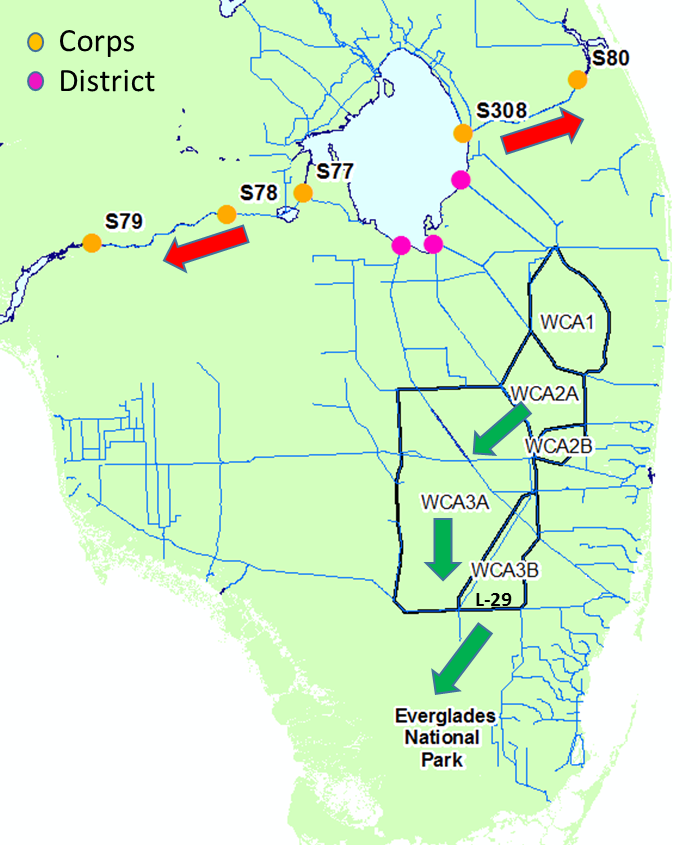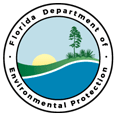|

FOR IMMEDIATE RELEASE: March 7, 2016
CONTACT: DEP Press Office, 850.245.2112, DEPNews@dep.state.fl.us
DEP'S DAILY UPDATE ON LAKE OKEECHOBEE
In an effort to keep Floridians informed of the state’s efforts to protect the environment, wildlife and economies of the communities surrounding Lake Okeechobee and the Caloosahatchee and St. Lucie estuaries, the Florida Department of Environmental Protection is issuing a Lake Okeechobee status update each weekday. These updates will help residents stay informed of the latest rainfall and lake level conditions, as well as the latest actions by the State of Florida and U.S. Army Corps of Engineers.
Summary of the State of Florida’s Actions:
- The South Florida Water Management District continues to take additional steps to lower water levels within its regional water management system. Click here for more information.
- On March 4, 2016, DEP and the District announced they would be deploying temporary pumps to move additional clean water (water that meets water-quality standards) from the flooded Everglades Water Conservation Area 3 into Everglades National Park.
- By raising the L-29 canal level, per an order from the U.S. Army Corps of Engineers and at the request of Governor Rick Scott, the South Florida Water Management District has been able to move approximately 14.1 billion gallons of clean water into the northern portions of Everglades National Park, as of midnight on March 6, 2016.
- Water managers continue to move up to 96 million gallons of water per day into the C-4 Emergency Detention Basin in southern Miami-Dade County.
- Also in Miami-Dade County, pump stations are being utilized at the S-25B and S-26 structures to help maximize discharges to tide from the Miami Canal.
- On March 3, 2016, the U.S. Army Corps of Engineers announced that it would reduce the amount of water flowing from Lake Okeechobee beginning March 4, 2016. Click here for more information.
- On March 2, 2016, Governor Scott announced that the Florida Department of Economic Opportunity (DEO) would immediately activate a business emergency operations center. DEO has begun to assess the impact the federal government’s water releases from Lake Okeechobee is having on businesses. Click here for more information.
-
On Feb. 26, 2016, Governor Rick Scott signed Executive Order 16-59, which declares a state of emergency in Lee, Martin and St. Lucie counties, following heavy rainfall that has resulted in the U.S. Army Corps of Engineers frequently discharging water from Lake Okeechobee to the St. Lucie and Caloosahatchee estuaries. This is a result of inadequate funding by the federal government. Governor Scott called on the Obama Administration to fully fund the more than $800 million in needed repairs to the federally operated Herbert Hoover Dike to safely hold water to prevent these discharges. To view the Executive Order, click here.
- On Feb. 11, 2016, Governor Rick Scott requested that the U.S. Army Corps of Engineers take immediate action to relieve flooding of the Everglades Water Conservation Areas and the releases of water from Lake Okeechobee to the Caloosahatchee and St. Lucie estuaries. Click here to read the letter.
- The Florida Department of Environmental Protection and the Florida Fish and Wildlife Conservation Commission (FWC) issued orders on Feb. 11, 2016, that would allow the U.S. Army Corps of Engineers to move forward with this request. Click here to read the orders.
-
On Feb. 15, 2016, the U.S. Army Corps of Engineers agreed to Governor Scott’s request to raise water levels in the L-29 canal in order to move water south through Shark River Slough to ease the effects of flooding in the Everglades. The South Florida Water Management District began operation of the S-333 structure at 5:30 p.m. on Feb. 15, 2016, after the state received an execution order from the U.S. Army Corps of Engineers.
Lake Conditions:
|
Current Lake Level
|
15.72 feet
|
|
Historical Lake Level Average
|
14.49 feet
|
|
Total Inflow
|
3,650 cubic feet per second
|
|
Total Outflow
(by structures operated by the U.S. Army Corps of Engineers)
|
6,770 cubic feet per second
|
|
Net
|
(3,120) cubic feet per second
|
|
Lake level variation from a week ago
|
(.24) feet
|
Florida Fish and Wildlife Conservation Commission's Wildlife Update:
The FWC continues to monitor water levels and the status of wildlife in three Wildlife Management Areas (WMAs) in South Florida within the Everglades ecosystem. The three areas, Everglades and Francis S. Taylor WMA, Holey Land WMA and Rotenberger WMA, encompass 736,881 acres. These WMAs provide important habitat for a diversity of imperiled wildlife species, including the Everglades snail kite, Everglades mink, little blue heron, tri-colored heron, snowy egret, white ibis, wood stork and limpkin, as well as native and abundant species like American alligators, white-tailed deer and marsh rabbits.
-
FWC’s monitoring efforts include periodic wildlife and habitat surveys. FWC staff continues to watch water gauges to monitor high water levels and the impacts and stresses they may be having on areas like the Everglades tree islands, which are critical to the survival of Florida wildlife species. High water levels can seriously impact nesting and feeding activities of our native birds and make large and small mammals much more vulnerable to disease, starvation and predation. The condition of habitat on tree islands is an important indicator for the level of stress being experienced by wildlife.
-
As of March 4, 2016, water levels within the three WMAs previously listed have continued to remain above or near FWC criteria for special regulations that limit public access. Water levels in all three WMAs continued to recede slightly or remain the unchanged during the past 24 hours.
Everglades WMA:
- Water level (average of 62/63 gauges) as of March 4 = 11.93 feet
- High water closure criteria = 11.60 feet
- Regulation schedule = 10.07 feet
- Recession rate for the last week = (0.10) feet
- Water level trend over the past 3 weeks = dropping
Rotenberger WMA:
- Water level as of March 4 = 13.11 feet
- High water closure criteria = 13.50 feet
- Regulation schedule = 12.75 feet
- Recession rate for the last week = (0.10) feet
- Water level trend over the past 3 weeks = dropping
Holey Land WMA:
- Water level as of March 4 = 12.33 feet
- High water closure criteria = 12.50 feet
- Regulation schedule = 11.46 feet
- Recession rate for the last week = (0.10) feet
- Water level trend over the past 3 weeks = dropping
Wildlife surveys conducted on WMA levees and tree islands during the past week suggest use by a variety of wildlife continued to increase, even though water levels in two of the WMAs have receded below criteria for special regulations. Surveys also indicate that fawning season has begun, which will continue during the next few months.
As long as water levels remain high, conditions of upland areas as well as the wildlife dependent on them will continue to be impacted. As of March 4, 2016, this high water event has lasted 35 days.
As a result of FWC’s continued observations, the special regulations that limit public access for the three WMAs will continue. As water levels drop significantly below the established criteria, wildlife will have delayed reactions and conditions typically do not improve for at least a week or more. Once conditions improve for wildlife, FWC will recommend an order to rescind the current special regulations.
Members of the public should report any distressed fish or wildlife to the following FWC hotlines:
- Wildlife Alert Hotline: 1-888-404-3922 or Tip@MyFWC.com
- Fish Kill Hotline: 1-800-636-0511
Lake Okeechobee Management Information:
|

The figure above depicts various flood control structures that the U.S. Army Corps of Engineers (Corps) and the South Florida Water Management District (District) operate. The arrows illustrate the direction of water flow. The red color indicates that, as of
Feb. 18, 2016, the discharges from the structures operated by the Corps are at levels that lower salinity and impact the estuarine ecology. The green arrows show the movement of water from the water conservation areas into the L-29 canal at a protective amount for Everglades National Park. The District began this movement on Feb. 15, 2016, after receiving an execution order from the Corps at the request of Governor Scott.
|
|
Structures
(see map above)
|
Federal Release Guidance
(based on 2008 Lake Okeechobee Regulation Schedule)
|
Daily Average Releases
(based on the U.S. Army Corps' C&SF System Status Update as of midnight 3/06/16)
|
|
South - 3 structures (operated by South Florida Water Management District)
|
0 CFS
|
0 CFS
|
|
East – S-308 (operated by U.S. Army Corps of Engineers)
|
N/A
|
1,750 CFS
|
|
East – S-80 (operated by U.S. Army Corps of Engineers)
|
Up to 2,800 CFS
|
1,890 CFS
|
|
West – S-77 (operated by U.S. Army Corps of Engineers)
|
Up to 6,500 CFS
|
3,830 CFS
|
|
West – S-79 (operated by U.S. Army Corps of Engineers)
|
N/A
|
4,410 CFS
|
|
The table above depicts the guidance for releases from the lake based on
the Corps' 2008 Lake Okeechobee Regulation Schedule as compared
to the actual daily average releases.
|
Salinity Conditions:
Caloosahatchee Salinity Conditions: Salinity (based on optimal conditions for adult oysters) is in the good range at Sanibel, in the fair range at Shell point and in the poor range at Cape Coral.
St. Lucie Salinity Conditions: Salinity at the U.S. 1 bridge remains the same and continues to be in the poor range.
Rainfall Information:
In January 2016, South Florida experienced the wettest January on record since recordkeeping began in 1932. Over the past three days, there has been 0.003 inches of rainfall over the region.
South Florida Water Management District's Rainfall Forecast:
Rainfall for the current week is forecast to be below average. Mainly dry this week with scattered showers to the east today as a cold front currently crosses through Central Florida. Shower coverage with the cold front is limited.
|



